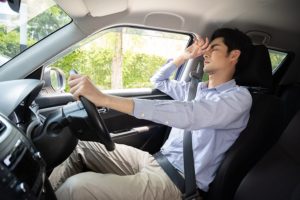Common Car Accidents and How You Can Help Avoid Them
March 8, 2022 | Car Accidents
Some car accidents are more common than others, and if you stay aware of the crashes that regularly happen, you might have a better chance of avoiding them. However, you cannot prevent other drivers from making mistakes, so these accidents will continue to occur. If another driver’s negligence leaves you injured in a car accident, consult with an experienced car accident attorney as soon after the accident as you can.
Can You Avoid the Most Common Car Accidents?
The most common car accidents are rear-end accidents, head-on collisions, T-bones, sideswipes, and rollovers. Most of these happen due to the negligence of other drivers, but you can try to avoid collisions by driving defensively and always paying attention to the road. Even if you are safe, you cannot always avoid suffering injuries in accidents that other drivers cause.
Rear-End Accidents
Rear-end Accidents are often the result of distracted drivers who fail to pay adequate attention to traffic. The National Transportation Safety Board (NTSB) reports:
- Almost half of all the car accidents involving two vehicles over the last three years were rear-end accidents.
- Every year, rear-end accidents kill about 1,700 people across the nation.
- A comprehensive study by the National Highway Traffic Safety Administration (NHTSA) found that 87 percent of all rear-end accidents in 2007 involved a distracted driver.
Far from being the mere fender benders that many people consider them, rear-end accidents are both more common and more deadly than most people realize.
Head-On Collisions
Head-on collisions are disastrous accidents that involve one driver going the wrong way headlong into oncoming traffic, and they are as terrifying as they are likely to be fatal.
Head-on collisions tend to involve a significantly impaired driver, someone who fell asleep at the wheel, a driver who passes another vehicle when it is not safe to do so, or someone who gets pushed into oncoming traffic via the force of a precipitating accident.
According to the Insurance Information Institute (III), both the following apply to head-on collisions:
- Head-on collisions were responsible for nearly 11 percent of all fatal accidents in one year.
- When vehicles of similar weights traveling at similar speeds (of over 56 miles per hour) collide head-on, the resulting injuries of the vehicle occupants often include severe brain injuries, neck injuries, and broken legs.
It’s difficult to over-emphasize exactly how dangerous head-on collisions are.
T-Bone Accidents
T-bone accidents refer to those accidents in which one vehicle drives directly into the side of another, and they often happen at intersections. T-bone accidents are more dangerous because the vehicles we drive don’t have much in the way of protection built into their sides (the way they do at the front with the hood and the back with the trunk, which both serve to buffer the impact in the event of a collision). T-bone accidents happen because motorists fail to pay adequate attention to or follow traffic lights, signs, and signals at intersections
Sideswipe Accidents
Sideswipe accidents happen when the sides of two vehicles come into contact with one another. The vehicles can travel in the same direction or in different directions when they swipe one another. All it takes is for one motorist to become momentarily distracted or to move into the other driver’s lane due to any other form of negligence. The impact of these sideswipe accidents is dangerous enough in and of itself, but it can also push the struck car into oncoming traffic, leading to further impact and injury.
Rollovers
Rollover accidents happen when a vehicle’s tires lose contact with the road, and the car flips over onto either its side or top in the accident. It likely comes as no surprise that rollovers are some of the deadliest car accidents. III reports a significant increase in fatal traffic rollovers over two recent years.
Most Common Causes
According to the III, the driving behaviors most commonly associated with fatal car accidents of all kinds include:
- Driving too fast for road conditions or over the speed limit accounted for 17.2 percent of all fatal traffic accidents.
- Driving under the influence of alcohol, drugs, or both accounted for 10.1 percent of all fatal traffic accidents.
- Failing to yield the right of way as required accounted for 7.3 percent of fatal traffic accidents.
- Failing to remain in the appropriate lane accounted for 6.6 percent of fatal traffic accidents.
- Carelessly operating a vehicle accounted for 6.5 percent of all fatal accidents.
- Distracted driving accounted for 5.9 percent of all fatal traffic accidents.
- Failing to follow traffic signs, signals, lights, or officers directing traffic accounted for 4.0 percent of all fatal traffic accidents.
- Driving erratically, recklessly, or otherwise negligently accounted for 3.7 percent of all fatal traffic accidents.
- Overcorrecting or oversteering accounted for 3.1 percent of all fatal traffic accidents.
- Driving with one’s vision obscured by weather, glare, lights, buildings, trees, or other obstacles to a clear view accounted for 3.0 percent of all fatal traffic accidents.
- Driving while drowsy or ill accounted for 2.4 percent of fatal traffic accidents.
- Driving the wrong way on a one-way road or traveling on the wrong side of the road accounted for 2.4 percent of all fatal traffic accidents.
- Swerving or otherwise adversely reacting to high winds or slippery road surfaces accounted for 2.3 percent of all fatal traffic accidents.
- Improper turning accounted for .8 percent of all fatal traffic accidents.
Driver Negligence
Each of these common causes of car accidents is generally attributable to driver negligence in one form or another.
#1. Distraction
Distracted drivers allow their attention to drift away from driving safely, and increasingly, the distraction of choice is texting and other smartphone activities.
#2. Impairment
Getting behind the wheel while impaired by alcohol or drugs is always a terrible decision. Impaired drivers can experience physical, sensory, and cognitive deficits that leave them unfit to drive. They make our roads far more dangerous places.
#3. Exhaustion
Drowsy drivers, like drunk drivers, experience deficits that leave them more likely to cause dangerous car accidents. Motorists often fail to recognize the danger associated with drowsy driving, which can significantly increase the risk.
#4. Excess Speed
The danger associated with excess speed is twofold. First, motorists have less time and traveling distance to react safely to dangers on the road—making accidents more likely—and second, any accidents they cause are more deadly. Additionally, traveling at excessive speeds will increase the stopping distance required to bring the vehicle to a complete stop. If not for the excessive speed of the driver, an accident would never have occurred.
Don’t Delay Reaching Out to an Experienced Car Accident Attorney

Chis Dixon, St. Louis Auto Accident Attorney
If you have been injured by another driver’s negligence in any car accident, focusing on your recovery is key, and obtaining the compensation to which you are entitled can provide you with the means you need to do so.
Dealing with an insurance company by yourself is never a good idea. They have an army of claims adjusters and lawyers that will do everything to pay you as little as possible. Contact a well-qualified car accident attorney who can fight for the legal rights of injured clients like you.

